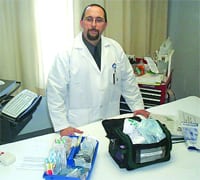Feeling the Strain The Escalating Battle Against the ‘Superbug’
Morgan Gilmore, nurse educator with Baystate Mary Lane Hospital in Ware, has been getting out into the community for years, educating people of all ages about public health and hygiene.
But recently, his audiences are a little more alert, if not on the edge of their seats, when Gilmore comes to call, sharing the latest news about MRSA – the bacterial infection that has become one of the medical profession’s most formidable foes.
“It can drive you crazy,” Gilmore said of following the MRSA trail. “It seems as though as soon as we get a handle on it, it morphs into something bigger and badder.”
MRSA (pronounced ‘mursa’) is short for methicillin-resistant staphylococcus aureus — a bacterium responsible for difficult-to-treat infections in humans. It typically begins as small red bumps that resemble pimples, boils, or spider bites, which evolve into deep, painful abscesses that often require surgical draining. Sometimes the bacteria remain confined to the skin, but they can also enter the body, causing potentially life-threatening infections in bones, joints, surgical wounds, the bloodstream, heart valves, or lungs.
For years, it was acquired most often during a hospital stay, particularly among patients with open wounds, invasive devices, and weakened immune systems, and treated with common antibiotics. However, MRSA is receiving renewed attention within the medical community of late, as a greater number of community-associated MRSA (CA-MRSA) cases are identified.
These new, antibiotic-resistant strains are harder to treat than hospital-acquired (HA-) MRSA, and have led some to probe into what this ‘superbug’ is and what it means for the public at large.
Biological Warfare
Dr. Robert Hoffman, an infectious disease specialist at Mercy Medical Center, said these new permutations of MRSA did not appear suddenly, but rather are the result of incremental changes to the bacteria.
“We’ve been dealing with this for a couple of generations,” he said. “But the fact is that staph aureus has been one of mankind’s worst pathogens for as long as we’ve known about pathogens.
“And as long as we’ve known about antibiotics, we’ve been trying to deal with this germ,” he continued. “Each time we’ve come up with an antibiotic that treats staph aureus, it came up with its own defense to combat them. Penicillin and methicillin could fight MRSA for a while, but the side effects made it difficult to use, and resistance built up.”
Hoffman said MRSA re-emerging in the media as the ‘superbug’ is the latest of these ongoing battles, but CA-MRSA is of particular concern because it has developed the ability to be more aggressive than its HA-MRSA counterpart. It has also become increasingly resistant to the most recent drug of choice to treat the disease — vancomycin.
“The germ has become drug-resistant and is causing more disease,” he explained. “A few years ago, people off the street — young people — were getting sick with MRSA, and we knew definitively that something had changed.”
He added that ‘community-acquired’ MRSA is also somewhat of a misnomer, because this new, hearty strain is also being seen in hospitals alongside its easier-to-treat cousin.
“It’s not that we’re seeing one strain here and one strain there,” he said. “The important thing to know is regardless of where it is acquired, CA-MRSA causes more disease — faster.”
Hoffman explained that, in essence, MRSA matures by finding ways around antibiotics; each generation tends to exhibit a new resistance and, sometimes, new pathogenicity, as is currently the case.
He added that as MRSA built up its resistance to various antibiotics, it gradually negated the effect of the most widely-used treatments, and until recently, physicians had few plan Bs on which to rely.
“The good news is three very potent antibiotics have become available just when we needed them,” Hoffman said. “These are more potent drugs with less toxicity that can do the job.”
Hoffman speculates that these new treatments, which include derivatives of cephalosporin, a relative of penicillin, will stave of MRSA for a time, but he speculates that eventually, those antibiotics may also fail and also play a role in moving MRSA toward its next generation.
“We have good therapies now, but we are always dealing with a moving target. Treating the infection changes the nature of the infection, so in a way we’re setting the stage for drug resistance.”
As such, some surgical treatments of MRSA that have been available for decades as a complement to antibiotics are still used in fighting the bacteria, and could see a resurgence.
“Often, with staph and other kinds of germs, a surgeon makes the difference,” said Hoffman. “Even though the new antibiotics are important, draining and lancing boils is a mainstay of treatment because it draws the infection out.”
Spreading the Word
With such pressing concerns regarding the elimination of MRSA once it enters the body, medical centers across the country are taking measures to tout the importance of prevention.
Gilmore said that because MRSA is such a strong bacteria, avoiding it is doubly important, calling attention to disease-prevention tactics in general. Thus, he’s charged with community outreach concerning MRSA; he’s routinely teaching groups of all ages about infection control, working with everyone from public schools to groups of EMTs to evaluate their own systems.
“MRSA can hang around for weeks — it’s tough to kill,” he said. “This is a case of the organism adapting to the medications used to fight it, and this has been helped along by people.”
Gilmore said patients with MRSA who do not finish their antibiotic prescriptions often do not kill the bacteria completely, and pass it on to others. In turn, basic hygiene can curb transmission rates, but too many people fail to understand how much of an effect the simple act of hand washing can have.
“Studies now show that two out every 10 women and three out of every 10 men don’t wash their hands on the way out of the bathroom,” he said. “The importance of hand-washing still hasn’t hit home, and this is a contact organism. It sits on surfaces, hands, and skin, and waits for an entry point into the body.”
Gilmore said once it’s on one’s skin, MRSA can often be easily washed off, but if not removed, it can colonize – and that can lead to infection in that person or someone they come in contact with.
“Once it’s under the skin, that creates boils, and those can lead to a blood infection,” he said.
As such, reducing the number of MRSA microorganisms has become integral to combating the disease; Gilmore calls it “decreasing the bioload.”
“Hand-washing, especially with liquid soap instead of bar soap, has become a huge part of maintaining public health,” he said. “Keeping skin moist and intact is also important, because cracks in the skin are like highways.”
Overall, Gilmore said all individuals need to be more proactive about cleanliness at home and especially in the workplace, disinfecting commonly used items such as computers and phones.
Shaking It Out
Leading the charge are the nation’s hospitals, which are introducing a number of new patient-monitoring systems in varying degrees, depending on the medical center and the needs of the community it serves.
“Hospitals everywhere are getting more aggressive about the care,” he said. “There are places in Europe now where everyone admitted to the hospital is tested, and Europe is experiencing about the same type of issue as the U.S.”
Gilmore said everyone who enters a Baystate Health facility with symptoms of MRSA has their medical care tailored to include several precautions.
“We treat it seriously and are building a team approach to attack MRSA,” he said.
Everyone who comes in contact with a MRSA or potential MRSA patient is gowned up, Gilmore explained, and once they leave their room, it is “terminally cleaned” — stripped of virtually everything and disinfected in its entirety.
Gilmore said Baystate Medical Center is also running terminal-cleaning drills to ensure that staff at many different levels complete proper processes, and some of its satellite locations, including Mary Lane, will soon follow suit with this practice.
Gilmore said he’s also seeing other trends in the workplace — sneezing into elbows, Roman (arm-to-arm) handshakes, and lots of waving.
“These days, no one wants to shake my hand,” he said, “but that’s proof I’m doing my job.”



Comments are closed.